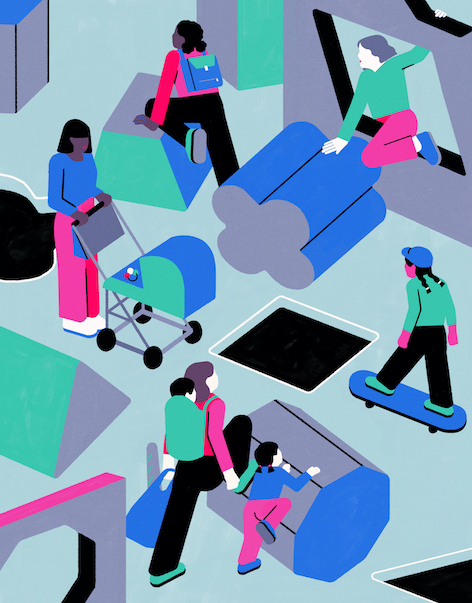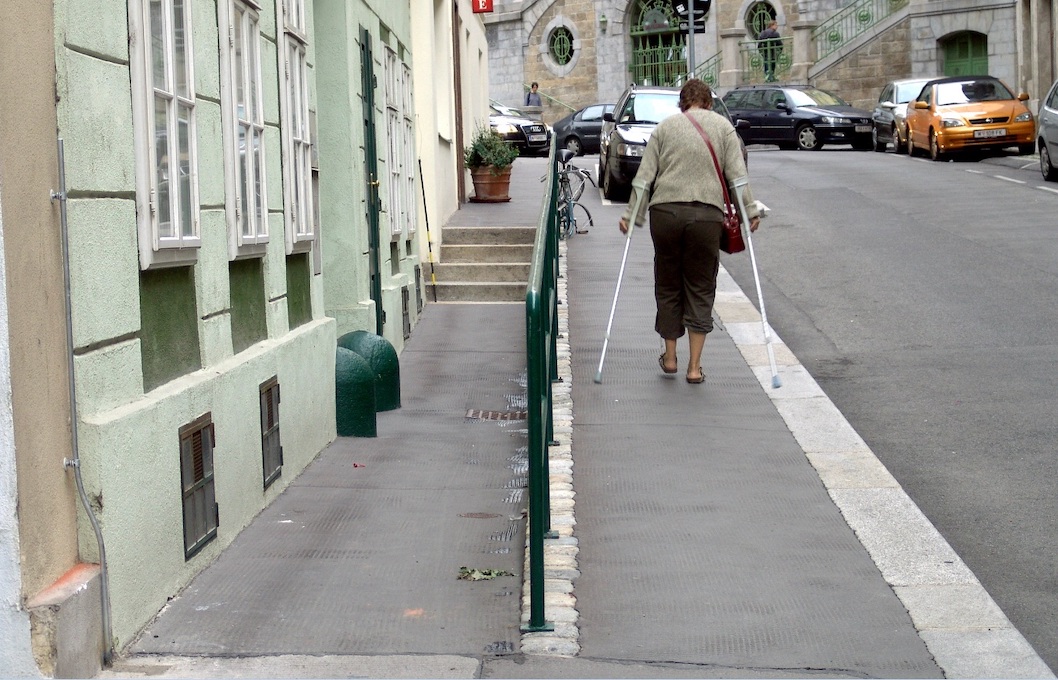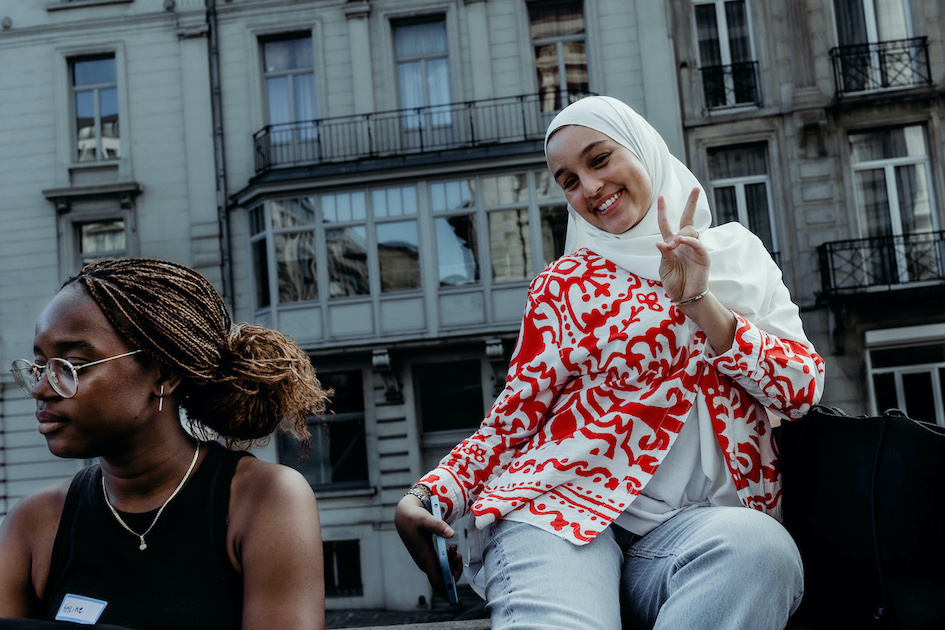Picture this: you’re the father of a young child and you have a job in the city centre. On a weekday morning, you hop in your car or catch a train and head to your office. You work until 5pm, and then you return home.
Now picture this: you’re a pregnant woman carrying a stroller down the stairs of a subway station, your toddler following behind you. On the platform, you wait 15 minutes or more because it’s 10:30am – off-peak hours – and fewer trains are running.
While avoiding the dark part of the platform where a man you can’t quite see is lingering, you struggle to entertain your young son. Finally the train arrives. You take your toddler to nursery, then take another train to work.
After several hours at the office, you take a tram to pick up your father for his doctor’s appointment. You travel back with your father to his home, then take a bus to collect your son, stop by the grocery store and load your stroller with the shopping.
To get home, you, your belly, your stroller and your son board the crowded train, earning you a few annoyed looks from other passengers. At the end of the day, you have paid several times for all your different trips.
One trip is simple: two equal lines, from A to B and B to A. The other trip is far more complex, with short, long and intersecting lines. In urban planning speak, this is called a ‘trip chain’. Because of gendered divisions of labour at home, women are far more likely than men to move in trip chains than in direct lines. They are also more likely to walk or use public transport and to travel at off-peak hours.
 Illustration by Maria Hergueta
Illustration by Maria Hergueta
These are just some of the findings that urban planners, geographers and sociologists have uncovered about the ways gender can shape someone’s experience of a city. This approach to urban design, which considers the way a city is built and the way people use it through the lens of gender, is called ‘gender mainstreaming’.
Today, people who apply a gender lens typically take an intersectionalist approach, also analysing other user demographics such as economic means, age, ethnicity, religion, sexuality and ability.
It’s about understanding the city is not designed with the needs of 50 per cent of the users in mind
The goals of the gender-mainstreaming approach include making public spaces available to people who have traditionally been pushed out of them; enhancing social connectivity; increasing public participation and representation of marginalised groups; and reducing real and perceived fears for people likely to face harassment.
Taking various user traits into account when building a city might seem intuitive, but the reality is that most cities have been built by white, middle-class, heterosexual, cisgender men for what they pictured as a typical user: a white, middle-class, heterosexual, cisgender man.
In the 1990s, Vienna became the first major city in the world to embrace gender mainstreaming as standard practice in city planning and, since then, the approach has slowly grown in popularity, with cities including Barcelona, Glasgow, Umeå in Sweden, and Lyon joining in.
In May last year, the city of Brussels posted a call for project ideas that focused on gender and urban planning. A total of €103,000 was distributed among six winning projects. “In Brussels, when we redo a public space, we think about mobility issues, about water issues, about historic components,” says Ans Persoons, the deputy mayor in charge of urbanism and public space. “We really wanted to add gender as a structural element.”
The pregnant mother’s trip chain journey described at the beginning of this article could happen to any caregiver. But, statistically, women are more likely to be the primary caregivers in the home. In the European Union, only one-third of families share care responsibilities equally between men and women.
Additionally, in the EU, women make up 62 per cent of all people providing long-term care to the elderly or to people with disabilities.
Though public transportation payments work differently in different cities, in New York City, for example, a study by New York University’s Rudin Center for Transportation Policy and Management found that women who are caregivers spend $75 (€68) more on public transport per month than men do.
Gender-sensitive urban planners take these factors into account to create innovative solutions for fairer cities. Mary Dellenbaugh-Losse, a consultant for inclusion and gender based in Berlin, has a PhD in human geography and has been working at the intersection of gender and urban development for four years.
“It’s not like we want special places that we paint pink,” she says. “It’s about understanding that the city is not designed with the needs of 50 per cent of the users in mind, and that it is beneficial and valuable to take that perspective because it improves the city for everyone, not just that one group.”
City planning is often done from the point of view of people who are in power
Some of the common changes that cities have implemented include dropped curbs, additional lifts, more lighting and a greater number of public toilets.
In Barcelona, the city’s mayor, Ada Colau, has made gender equity in all spheres a priority. In terms of urban planning, that has meant several changes. For one, the city has gathered data on women’s mobility. It showed that women make more trips during the day, at off-peak times, whereas men make more of their trips between 5pm and 8pm. In response, the city has created new bus networks that make trip chains easier.
It has also introduced safety audits for neighbourhoods. How well-lit are the streets? Are bushes no higher than one metre? (Greenery that is too tall can block sightlines into public spaces, making people feel less safe.)
The city has also put an emphasis on establishing more ‘superblocks’, groupings of nine blocks where traffic is limited, creating more opportunities for green spaces and play parks.
Dellenbaugh-Losse notes that gender-equitable solutions often go hand in hand with sustainability goals. In Umeå, Sweden, officials set a goal to get 55 per cent of residents to move around by sustainable means – by bus, bike or on foot. When the municipality gathered gender-disaggregated data about mobility patterns, they found that 56 per cent of women already used these three methods, compared to 40 per cent of men.
“In that situation it was about encouraging men to be more sustainable,” Dellenbaugh-Losse says.
The topic of gender mainstreaming in urban design, as we know it today, made a big splash in 1991, when a photography exhibition in Vienna showed the daily lives of eight women and girls, including a retiree and a wheelchair user. “At that point, nobody spoke about public space,” says Eva Kail, one of the exhibition’s organisers and now the gender planning expert in Vienna’s executive planning group of construction and technology.
Over the course of the 1990s, the city opened a ‘women’s office’; began assessing the ways in which a city can support or hinder unpaid care work; and started collecting information on the ways in which women and men move differently through the city.
With the co-operation of more than a dozen municipal departments, from the early 1990s to the early 2010s, Vienna launched 60 pilot projects that target gender-specific aspects of urban planning. In one district, for example, sidewalks were widened, giving more space to people with prams or in wheelchairs; street lamps were added or fixed; and a lift was installed near a long staircase.
A ‘fairness check’ was established to ensure that future urban design projects account for different types of users. “You think of the five or six groups who will be most affected by the changes or who you think are the most relevant future users, and then you discuss the proposed measurements, if this will have an impact, and what kind of impact,” Kail explains.
 As part of a neibhourhood pilot project in Vienna's Mariahilf, planers have expanded sidewalks and made areas with stairs more accessible | Photo: Wolfgang Gerlich
As part of a neibhourhood pilot project in Vienna's Mariahilf, planers have expanded sidewalks and made areas with stairs more accessible | Photo: Wolfgang Gerlich
Because a large portion of the housing in Vienna is government-subsidised, planners were also able to apply an inclusivity lens to people’s homes. Today, developers wanting to build housing with more than 300 units have to pass the fairness check.
For example, Kail says, rooms for storing strollers and bicycles should be spacious, easily reachable and have natural lighting. Staircases should be easy to use, and underground car parks should be carefully considered, as they can often cause safety concerns for women.
“We don’t want a [communal] garbage room that is hidden and in a dark corner, and you’re afraid to go there and use it,” says Kail. Apartment layouts should be flexible and adaptable to different family arrangements – after all, the heterosexual male and female nuclear family model is hardly the norm these days.
In Brussels, one of the projects chosen to receive funding last year is called Girls Make the City. Two organisations, ZIJkant and Wetopia, teamed up to rejuvenate a skate park in the central Brussels neighbourhood of Marolles.
Parks have been a major focus for urban planners interested in equity. Studies have consistently found that, after a certain age – typically the point at which girls are no longer accompanied by parents – girls stop using parks.
A recent study by Kind & Samenleving conducted in Belgium found that among children aged three to 14 who were playing outside, only 37 per cent were girls. In the nine- to 11-year-old range, that share was even lower, at 27 per cent. In sports zones, the study found, 15 per cent of the children were girls.
To tackle this problem locally, ZIJkant and Wetopia recruited 25 girls and women between the ages of 16 and 26 from Marolles to collaboratively dream up proposals to make the area around a skate park by the Place de la Chapelle more welcoming to them. Each participant was paid €35 a day.
We chose teenage girls because that’s the group that feels least at ease in public space. We wanted to give them the power to lead the process from the beginning to the end
“Teenagers don’t [always] have the economic means to [buy] a coffee or go to McDonald’s, so they really have to be in public spaces if they want to meet outside of their home,” explains Julie Van Garsse, a staff member at ZIJkant.
“We chose teenage girls because that’s the group that feels least at ease in public space. We wanted to give them the power to lead the process from the beginning to the end.”
The group started their work by doing a three-hour walk around the neighbourhood, led by Joke Quintens, a social designer and the founder of Wetopia. “Every space where they can do sports or hang out was fenced off,” Quintens recalls. “They wanted more colour, trees, plants. There was also a lack of toilets. For a boy, it’s really easy. Even if there’s no toilet, there’s always a solution.”
Eventually, the group came up with nine proposals, then worked with architects to figure out how to enact them. One successful idea was an Occupation Box, a literal box inside which are chairs and lights, that the girls can bring to different parts of the park when they want to sit together comfortably.
Another idea was to establish a programme of activities, including construction workshops to build skate ramps, as well as martial arts and skateboarding classes. As Persoons explains: “We learned it’s not only about how you construct the space, but also how you animate it. Girls want to know there will be other girls there, and we help them organise themselves.”
The girls presented these ideas and plans at a big neighbourhood party in front of Mayor Philippe Close. Van Garsse adds: “City planning is often done from the point of view of people who are in power, and those are, in general, white, cisgender, heterosexual men, and they don’t really feel or experience the same thing as girls, especially girls in very diverse neighbourhoods.”
One topic that came up repeatedly as the girls and women envisioned their ideal public space, was the prevalence of street harassment. “We knew it existed but we didn’t want to stress it because it’s a bit out of our hands,” Van Garsse says.
“But [the girls] were really focused on this.” Ninety-one per cent of girls between the ages of 15 and 24 in Brussels, Antwerp and Charleroi have experienced sexual harassment, according to a survey by Plan International.
It’s not like we want special places that we paint pink
The group came up with two ideas: a chalkboard-style Wall of Truth mural in the skate park on which anyone would be able to write about their experiences with harassment, and a ‘microaggression workshop’ that teaches people about appropriate bystander interventions in cases of harassment, and about the ways in which people who present as female are treated differently from those who present as male in public.
A school near the skate park will make the workshop mandatory for all students in their last year of high school. And the Girls Make the City group is working on turning the workshop into an app or a game that visitors to the skate park can download with a QR code.
 The Girls Make the City project in Brussels is in the Marolles neibhourhood | Photo: Lynne Delbeecke
The Girls Make the City project in Brussels is in the Marolles neibhourhood | Photo: Lynne Delbeecke
Persoons says the six projects the city funded offered lessons for her department. One was how crucial user participation is to building fair cities. A current project on her agenda is to replan the Place du Nouveau Marché aux Grains, also in the Brussels city centre.
Already, her department has gathered data about how the square is used by different genders at different points in the day, and invited children from secondary schools in the area to discuss how they use the square.
Kail is keen to extol the need for cities to develop a ‘participation’ culture. “People don’t have the idea they can change something, have influence and impact,” she says.
And Persoons herself demonstrates another critical aspect of making cities fairer: having diverse representatives with decision-making power. “I have a general vision of how a city should develop and I’m a convinced feminist, so this is how those two go together,” she says.
Kali adds: “Vulnerable groups don’t create a lot of problems. Migrants don’t have the right to vote. Elderly people are too weak to fight for their rights. Children have no votes. In our democratic systems, for reasons of age or mental or physical fitness, many people are not in a situation to apply pressure.”
Gender mainstreaming, it turns out, is about more than gender. As Dellenbaugh-Losse says: “It’s about different people with different life experiences looking at the same thing and being able to collectively describe the problems, instead of one person looking at the trunk and one at the tail”.
Sign up to The Parliament's weekly newsletter
Every Friday our editorial team goes behind the headlines to offer insight and analysis on the key stories driving the EU agenda. Subscribe for free here.